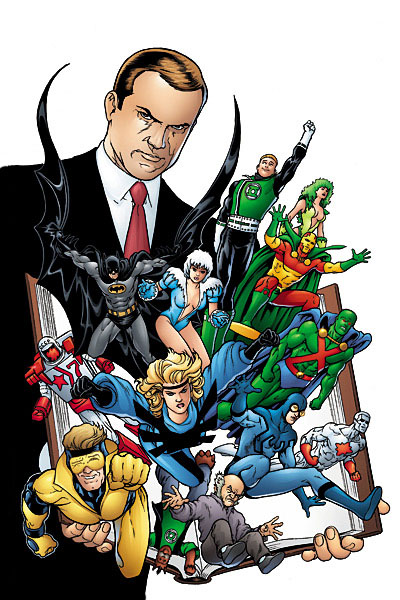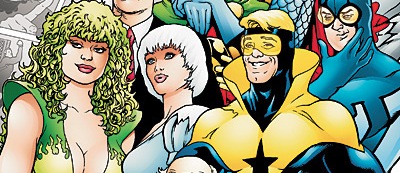Call me crazy, but I think stories about superheroes should be fun. And in the late 1980s, there was one group of heroes whose stories were not only fun but funny too.
In 1987, DC relaunched its Justice League of America comic as the simply titled Justice League. Written by Keith Giffen and J.M. DeMatteis and illustrated by Kevin Maguire, it stood out from everything else on the stands because it was … well, goofy.
The team that Giffen and DeMatteis assembled was a mix of big guns (Batman, Captain Marvel, the Martian Manhunter) and real pistols (Booster Gold, Guy Gardner, the Blue Beetle). The latter group of heroes may not have been cut-ups in their previous appearances, but Giffen and DeMatteis turned them into buffoons. These heroes bickered and made fun of each other and cracked stupid jokes — all while routinely saving the world, of course. This era in League history is known as the “bwa-ha-ha” era for the way DeMatteis wrote belly laughs. (Giffen handled the basic plots, while DeMatteis wrote the dialogue.)
 This tomfoolery was a bold move, given the “grim and gritty” state of comics at the time. The most popular title of the ’80s was Marvel’s Uncanny X-Men, a soap opera in spandex if there ever was one. And only a few years earlier, DC itself broke new ground with Watchmen and The Dark Knight Returns, two series that spawned hordes of imitators trying to bring a more serious tone to superheroes.
This tomfoolery was a bold move, given the “grim and gritty” state of comics at the time. The most popular title of the ’80s was Marvel’s Uncanny X-Men, a soap opera in spandex if there ever was one. And only a few years earlier, DC itself broke new ground with Watchmen and The Dark Knight Returns, two series that spawned hordes of imitators trying to bring a more serious tone to superheroes.
The League’s lighter side lasted into the early ’90s while enduring a few title changes. Justice League became Justice League International, which was then switched to Justice League America to differentiate it from a spin-off book, Justice League Europe, also written by Giffen and DeMatteis. Maguire drew 24 of the first 29 issues of the original series, then reunited with his writing partners a decade later for a couple of sequels: 2003’s Formerly Known as the Justice League and 2005’s I Can’t Believe It’s Not the Justice League. (Those titles ought to be a clue that the trio had not gotten more serious with age.)
You might think the current regime at DC is ashamed of this era in Justice League history, given how other writers have abused the characters over the past few years. The 2004 best seller Identity Crisis began with the murder of Sue Dibny, the wife of the Elongated Man. One of DC’s biggest blockbuster crossovers, Infinite Crisis, was sparked by Max Lord (the league’s benefactor in the Giffen-DeMatteis era) shooting the Blue Beetle in the head. In a sequel to that series, Final Crisis, the Martian Manhunter was killed off almost as an afterthought, a casual death hardly befitting a character with 50 years of history under his belt.
 But DC is finally making an effort to lighten the mood of its entire line, under the banner label of “Brightest Day,” so now the goofy Justice League characters and their creators are back.
But DC is finally making an effort to lighten the mood of its entire line, under the banner label of “Brightest Day,” so now the goofy Justice League characters and their creators are back.
Giffen is plotting a biweekly, 26-part series called Justice League: Generation Lost, the third issue of which goes on sale today. His writing partner is Judd Winick, whom non-comics readers might remember as the cartoonist from the “Puck and Pedro” season of MTV’s The Real World.
Also in stores today is Booster Gold No. 33, which is being written by Giffen and DeMatteis. (The cover of the previous issue, their first on the series, bore this blurb: “Giffen & DeMatteis reunite to bring the bwa-ha-ha back to Booster Gold!”)
I’m more likely to keep buying the latter series than the former, for two reasons: 1. Giffen and DeMatteis make for a better team than Giffen and Winick. I was too young to realize it in the ’80s, but it turns out that DeMatteis was the one contributing much of the jokes. 2. Booster Gold is a series about a time-traveling hero, so we’re likely to see a return to the era I remember so fondly. “Brightest Day” or not, DC’s current continuity is a little heavy for my tastes.
What’s missing from both series, though, is interior art from Maguire. He’s drawing covers for both Booster Gold and Justice League: Generation Lost, but that’s not enough for me. Part of what made Giffen and DeMatteis’ humor work back in the day was Maguire’s talent for drawing facial expressions. He had looks of disgust, bemusement, and smirks in his portfolio. Without his visual contributions, many of the jokes just fall flat.






